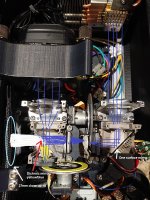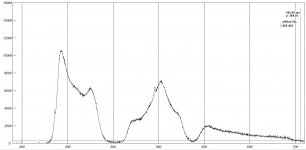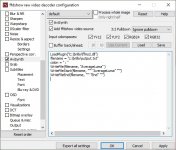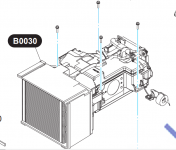Thats very nice!
I am quite interested in the optics used. Seems like you converted one Osram array to white and used another one to have blue? I also see several lenses and a "diffuser" wheel? Do you have problems with speckle as you use blue directly? Do you use a despeckler?
How is the Phosphor holding up? Which one did you use? Why not a allready manufactured phosphor wheel (should be more efficient)?
How do you do the black frame detection? Whats your Laserdriver?
SOO many questions, please dont let me die dumb. Thanks for sharing your project!!
I think Water-cooling is the way to go for a upgrade.
It could (if designed correctly) be much less noisy than the cooling for the UHP lamp. Quickconnects for the (small) waterlines are easy and cheap. This gives the possibility to have the radiator a few cm/m away from the PJ, reducing the noise at the watching position even further.
As this would make the PJ much colder inside, one could think about reducing the existing fans speed (or number). However one would need to program a little board that emulates a fan with the right speed. As most PJ are checking the fans for speed/function. Design of this board would be easy for me.
For wavelength: 410/405nm is impossible for the Osram array. Its likely around 445nm. How hot does your laser run? These modules drift quite a bit with temperature. Increase it if possible, this would give you a higher wavelength blue thus less violet. Just dont run it too hot, check the data sheet. Otherwise 455nm is the way to go.
I dont have any PJ related measurement equipment, only a spectrometer and Lux meter but i hope i can still develop something that i could use for my VW270.
I am quite interested in the optics used. Seems like you converted one Osram array to white and used another one to have blue? I also see several lenses and a "diffuser" wheel? Do you have problems with speckle as you use blue directly? Do you use a despeckler?
How is the Phosphor holding up? Which one did you use? Why not a allready manufactured phosphor wheel (should be more efficient)?
How do you do the black frame detection? Whats your Laserdriver?
SOO many questions, please dont let me die dumb. Thanks for sharing your project!!
I think Water-cooling is the way to go for a upgrade.
It could (if designed correctly) be much less noisy than the cooling for the UHP lamp. Quickconnects for the (small) waterlines are easy and cheap. This gives the possibility to have the radiator a few cm/m away from the PJ, reducing the noise at the watching position even further.
As this would make the PJ much colder inside, one could think about reducing the existing fans speed (or number). However one would need to program a little board that emulates a fan with the right speed. As most PJ are checking the fans for speed/function. Design of this board would be easy for me.
For wavelength: 410/405nm is impossible for the Osram array. Its likely around 445nm. How hot does your laser run? These modules drift quite a bit with temperature. Increase it if possible, this would give you a higher wavelength blue thus less violet. Just dont run it too hot, check the data sheet. Otherwise 455nm is the way to go.
I dont have any PJ related measurement equipment, only a spectrometer and Lux meter but i hope i can still develop something that i could use for my VW270.








